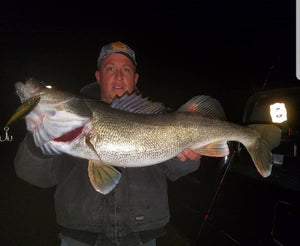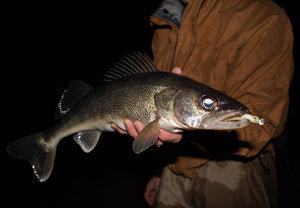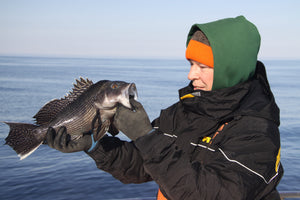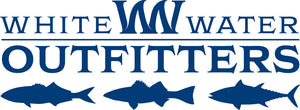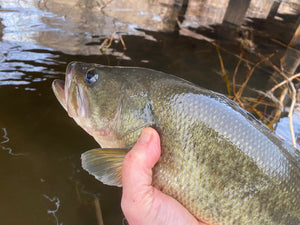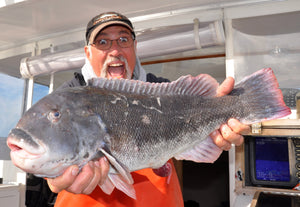Don't Forget Your Spinnerbaits

With waters at exceptionally high levels this year in local lakes and ponds, sweetwater fans should have an opportunity to really take advantage of some great hard-hitting action with largemouth bass and big chain pickerel between early June and mid-summer. That high water provides a little bit of extra space between thick weeds and the surface in areas where the depth drops off a bit, opening up select stretches to lures you just can’t drag through the salad.
Enter the spinnerbait, a super-successful, time-proven artificial that has been around for decades but is sometimes overlooked locally for the general ease of weedless plastics. That lessened emphasis on the bladed baits across Long Island can actually be your edge though as their moderate to quick retrieves, obvious flash, and generally larger profiles can turn the heads of lunkers looking for a change of pace.
Smaller spinners are excellent for a lot of the smaller ponds that we have here on Long Island.
Which Blades When?
Although spinnerbaits appear simple in design, there are several elements to consider when making your selection before heading out on your favorite fishing hole. Take the blades, for example. There are three primary styles, each with different strong suits.
In clear water where bass and pickerel use sight as the key element in locating prey, narrow willow leaf blades are a great choice because they throw off plenty of flash. Rounded Colorado blades throw off less light but work well in discolored or murky water because they give off stronger vibrations. Indiana or tear-drop style blades, which fall in-between these other two styles, offer a fair degree of flash with a decent level of vibration, making them a good compromise under mixed conditions.
Skirts and grub tails provide color and contrast to a spinnerbait, and choosing an appropriate shade for the environmental conditions encountered is key. Choose white or yellow on sunny days and June Bug or Chartreuse under cloudy skies or in low-light situations. If you think big bass and pickerel are targeting large baitfish, or simply want to present a fuller, larger target, combine a skirt and grub by sliding the latter up onto the hook and under the skirt. Matching the grub color to that of the skirt is usually a good idea, but some sharpies prefer a little more contrast. A white skirt and red grub combo, for example, works well when the water is somewhat chilly. Purple and red is a good combination just before dark.
Even the arm of a spinnerbait is worthy of consideration when it comes to fine-tuning your presentation. Thinner arms work well with lighter lines and allow a little flex as the blades spin to throw off unique flash and vibrations. Thicker arms, however, stand up well to banging structure, snagging fallen timber and being pounded repeatedly by quality fish.
As a soft rule, toss smaller spinnerbaits with wire thicknesses of 0.03 to 0.04 on four- to six-pound test spinning setups, especially when working in open water, as they draw plenty of aggressive strikes from bass to bluegills. On the other hand, should you choose to challenge the weeds, cast to shoreline brush or slowly retrieve spinnerbaits across sunken timber, you’ll want to bump up to a 10- 12- or 14-pound-test conventional setup and a spinnerbait arm thickness of 0.04 or 0.05. Some anglers will even go to titanium arms for working in heavy cover, but the steel arms tend to provide a little better action on the retrieve.
SIZE MATTERS
Of course, size does matter. Bigger spinnerbaits seem to turn on the largest bass and pickerel while smaller lures provoke more strikes but fewer trophies. When choosing a spinnerbait size, the starting point should be deciding what you want to target. If it is fast action with a variety of species, something along the lines of a 1/8-ounce Booyah Micro Pond Magic Spinnerbait, 3/16-ounce Booyah Pond Magic, Strike King Micro King or Strike King Mini King is ideal as will fit in the most mouths. Larger spinnerbaits, like a 3/8-ounce Blaze Spinnerbait and ½-ounce Strike King KVD cull out the sunfish, crappies, yellow perch and smaller bass, allowing you to concentrate on catching the kings and queens of the pond. Try tossing a small spinnerbait to get a quick feel for the aggressiveness of the predators on any given day, then switch to something larger once you've caught and released a few fish and want to get serious about hooking a trophy.
BASIC PRESENTATIONS
Spinnerbaits are exceptionally versatile, and just about any presentation that keeps the blades turning will eventually draw some strikes. Still, there are three retrieves that can cover all the bases: buzzing, standard and slow-rolling.
Buzzing spinnerbaits brings exciting topwater strikes and seems to work best on calm, overcast days when the air is heavy and the lake still. With this presentation, begin reeling quickly before the lure even hits the water. The idea is to retrieve your offering just below the surface so it pushes a bulging wake on the return. Alternate speeds slightly so that the blades occasionally break the surface and then slide below again without allowing the wake to fall off.
The standard spinnerbait retrieve is just what you might expect. Cast out and reel back at a steady, medium pace. Vary the speed slightly from cast to cast until you find a pace to which your quarry responds. Keep the lure anywhere from six inches below the surface to a foot above the bottom. This retrieve works especially well at mid-day, during spring and fall seasons, and in open water.
Slow-rolling is a great way to probe deeper waters for sulking bass and big pickerel. The idea behind this presentation is to work your lure slowly across submerged structure like trees, wrecks or large rocks. Try to bump any prominent piece that rises off the bottom. You'll lose some lures with this approach, but you might also hang your biggest bass of the season.”
- Bryce Poyer

